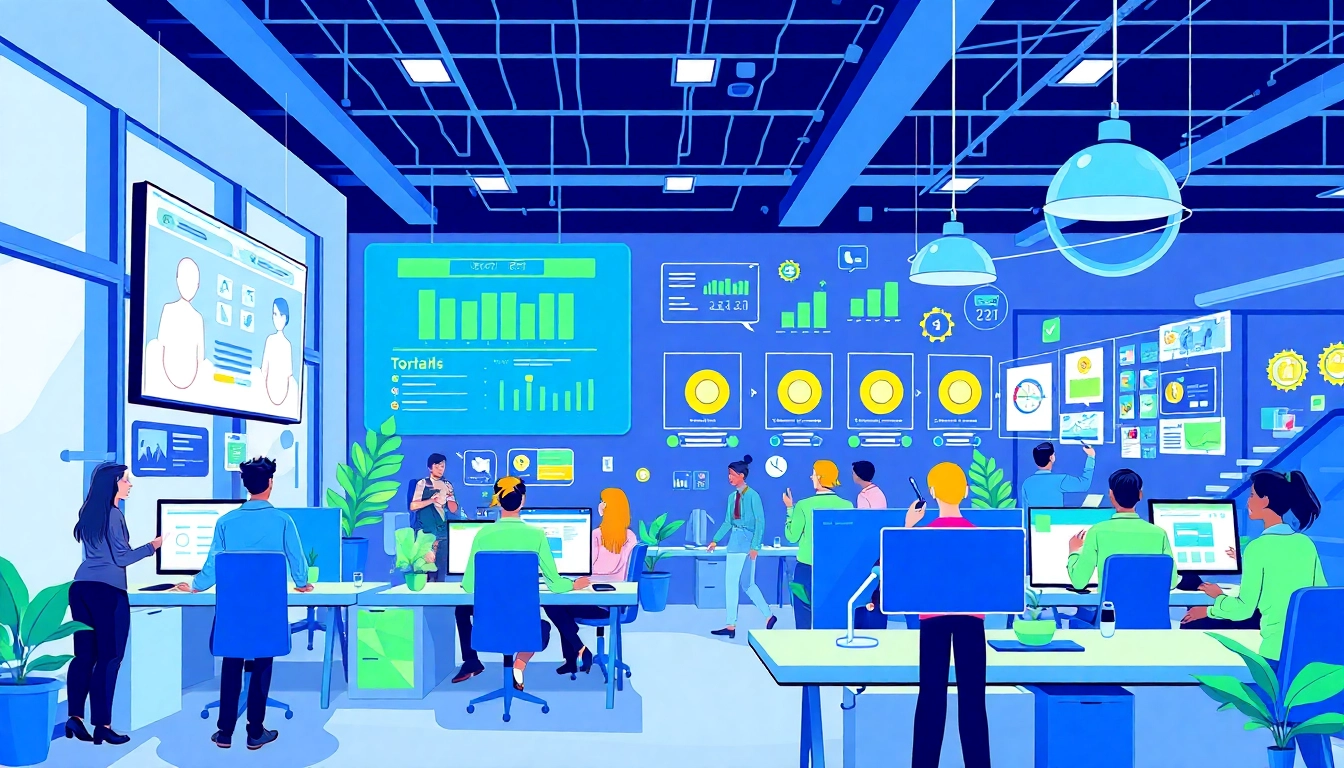Understanding Business Gamification
What is Business Gamification?
Business gamification refers to the application of game-design elements and principles in non-game contexts, particularly within organizational settings. It uses mechanics like points, badges, leaderboards, and challenges to motivate employees, enhance engagement, and increase productivity. The concept is grounded in the understanding that humans are naturally inclined towards play and competition, and it harnesses this inclination to make work more enjoyable and rewarding. Through implementing business gamification, organizations can reshape the way tasks are approached and executed, fostering both creativity and efficiency.
The Mechanics of Gamification in Business
To grasp the essence of business gamification, it’s essential to dissect its core mechanics. These include:
- Points: Points are awarded for completing specific tasks or achieving particular results. This instant feedback mechanism acts as a motivator, encouraging employees to engage actively.
- Badges: Badges symbolize accomplishments and expertise. When employees earn badges, it increases their status and recognition within the organization.
- Leaderboards: These create a competitive environment by displaying top performers. Leaderboards motivate individuals to strive for higher rankings, often resulting in enhanced productivity.
- Challenges: By introducing challenges, organizations can encourage teamwork and collective problem-solving, pushing employees to collaborate creatively.
Benefits of Business Gamification
The adoption of gamification strategies can yield several benefits for businesses including:
- Improved Employee Engagement: Gamification can significantly enhance engagement levels by making work fun. Engaged employees are often more productive and display higher job satisfaction.
- Enhanced Learning and Development: Incorporating game elements into training modules can make learning experiences more immersive, leading to better retention of knowledge.
- Increased Motivation: The intrinsic motivation generated by gamification can lead to a more dynamic workforce, eager to achieve targets and challenge themselves continuously.
- Better Collaboration: With features like team challenges and social interactions, gamification fosters a collaborative culture, breaking down silos within teams.
Implementing Business Gamification Strategies
Steps to Start Gamification
Successfully implementing gamification requires a detailed approach. Before deploying any game mechanics, businesses should take the following steps:
- Define Objectives: Identify the goals you want to achieve through gamification. Is it improving sales, enhancing customer service, or increasing employee training completion rates?
- Understand Your Audience: Knowing your employees—what motivates them, their challenges, and preferences—ensures that gamification elements align with their interests and behaviors.
- Select Appropriate Game Mechanics: Choose game elements that resonate with your objectives and audience. This might include a mix of points, badges, and challenges.
- Develop a Pilot Program: Test your gamified system with a small group before a full rollout. This pilot can uncover unforeseen challenges and provide insights for improvement.
Choosing the Right Tools
The tools you select to implement gamification in your business should be intuitive and scalable. Consider the following when choosing tools:
- User-Friendly Interface: The tool should be accessible for all users, from tech-savvy to novice, to foster participation.
- Scalability: As your business grows, your gamification platform should easily adapt to increasing numbers of participants and new features.
- Real-Time Analytics: Effective gamification requires monitoring effectiveness. Choose tools that provide insightful metrics on engagement and performance.
Create a Gamification Plan
A well-defined gamification plan outlines the structure, elements, and strategies that will be used to motivate and engage employees. Include the following components:
- Timeline: Establish when you will launch gamification initiatives and the duration of different phases.
- Metrics for Success: Define KPI’s to measure the impact of gamification. This might include engagement rates, task completion times, and feedback scores.
- Feedback Loops: Create channels for participants to provide feedback on the gamification process. This can guide future iterations and adjustments.
Challenges in Business Gamification
Common Pitfalls to Avoid
While gamification can be a powerful tool, there are pitfalls businesses must be wary of:
- Overcomplicating the Game: If the gamified system becomes too complex, it may cause confusion and disengagement. Simplicity is key.
- Focusing Solely on Competition: Although competition can be motivational, it’s essential to balance it with collaborative elements to cultivate a healthy work environment.
- Lack of Alignment with Business Objectives: Ensure that gamification strategies align with overall business goals. Misalignment can lead to wasted resources and disorganized efforts.
Measuring Engagement and Success
For gamification to be effective, its success must be measured accurately. Utilize a variety of methods to gauge both engagement and overall impact on organizational performance:
- Surveys and Questionnaires: Collect direct feedback from employees about their experiences and perceptions of the gamification program.
- Performance Metrics: Analyze metrics such as sales figures, customer service ratings, and completion rates before and after gamification implementation.
- Retention Rates: Examine the effect of gamification on employee turnover and retention as a long-term measure of success.
Adjusting Strategies as Needed
Flexibility is crucial in any gamification strategy. Regularly assess the effectiveness of your gamified approach and be prepared to make adjustments:
- Iterative Improvement: Use data from your metrics to refine challenges, rewards, and other aspects of the gamification process.
- Engagement by Feedback: Be responsive to employee feedback and suggestions, incorporating their insights to enhance engagement.
- Stay Current: As trends in gamification evolve, stay updated with the latest strategies and technologies that could benefit your implementation.
Real-World Examples of Business Gamification
Case Studies in Different Industries
Numerous organizations across diverse sectors have successfully implemented gamification strategies to notable effect. Here are some examples:
- Sales Teams: Companies like IBM have introduced gamified sales platforms to boost performance by awarding points for meetings, calls, and closed deals, significantly increasing motivation.
- Customer Service: Starbucks employs gamified systems through their rewards program where customers earn stars for purchases, incentivizing repeat business and enhancing customer loyalty.
- Health Sector: In healthcare, organizations have used gamification to encourage patients to adhere to medication schedules by leveraging points and rewards for consistent treatment.
Analyzing Success Stories
One potent example is the success of Nike’s ‘Nike Run Club’ app. This platform combines fitness tracking with gamified elements such as challenges and social sharing features. By implementing these features, Nike has not only increased engagement but also fostered a strong community of fitness enthusiasts who motivate each other, reinforcing brand loyalty.
Lessons Learned from Implementation
Organizations need to focus on a few key takeaways from these success stories:
- Community Building: Successful gamification often revolves around creating a sense of community among participants, which can enhance engagement.
- Balance Competition and Collaboration: While competition can drive performance, ensuring that team dynamics are encouraged can lead to greater overall success.
- Adaptability: Continually modifying gamification strategies based on evolving objectives and user feedback has proven crucial for sustained success.
The Future of Business Gamification
Emerging Trends in Gamification
The landscape of business gamification is continuously changing. Some emerging trends include:
- AI-Driven Personalization: The integration of artificial intelligence will allow gamification systems to provide highly personalized experiences based on individual user preferences and behaviors.
- Increased Use of Virtual and Augmented Reality: These technologies can further immerse users in gamified experiences, making tasks more engaging and enjoyable.
- New Business Models: With remote and hybrid working environments becoming commonplace, gamification strategies are evolving to cater to teams spread across various locations.
The Role of Technology
Advancements in technology will play a significant role in shaping the future of gamification in business. Data analytics tools will help organizations understand employee engagement better, while machine learning will enable the customization of game elements for individuals and teams.
Strategies for Long-Term Success
To ensure gamification remains effective and relevant, organizations should:
- Commit to Continuous Learning: Stay informed about the latest trends and research in gamification to refine your approach continually.
- Engage Stakeholders: Involve employees in the gamification process from the start—this creates a sense of ownership and investment in the success of the program.
- Align with Broader Organizational Goals: Ensure that gamification strategies support the overarching objectives of the company to drive cohesive progress.



